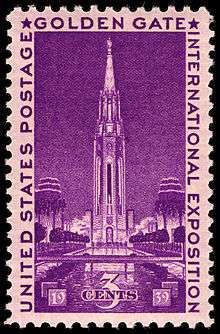Golden Gate International Exposition
| EXPO San Francisco 1940 | |
|---|---|
.jpg) A map of the Exposition | |
| Overview | |
| BIE-class | Universal exposition |
| Name | Golden Gate International Exposition |
| Area | 160 hectares (400 acres) |
| Location | |
| Country | United States |
| City | San Francisco |
| Venue | Treasure Island |
| Coordinates | 37°49′27″N 122°22′16″W / 37.8242°N 122.3710°WCoordinates: 37°49′27″N 122°22′16″W / 37.8242°N 122.3710°W |
| Timeline | |
| Opening | February 18, 1939 |
| Closure | September 29, 1940 |
| Universal expositions | |
| Previous | 1939 New York World's Fair in New York City |
| Next | Exposição do Mundo Português (1940) in Lisbon |
The Golden Gate International Exposition (GGIE) (1939 and 1940), held at San Francisco's Treasure Island, was a World's Fair celebrating, among other things, the city's two newly built bridges. The San Francisco–Oakland Bay Bridge opened in 1936 and the Golden Gate Bridge in 1937. The exposition opened from February 18, 1939, through October 29, 1939, and from May 25, 1940, through September 29, 1940.
Treasure Island
Treasure Island, a flat, geometrically-shaped, artificial island attached to Yerba Buena Island, was built for the Exposition near where the Oakland span and the San Francisco span of the Bay Bridge join. Built by the federal government, Treasure Island was to be an airport for Pan American's transpacific flying boats, like the China Clipper. Due to wartime needs, it was turned into a naval base used by the US Navy from 1941 to 1997.[1]
Pageant of the Pacific

The theme of the exposition was "Pageant of the Pacific", as it showcased the goods of nations bordering the Pacific Ocean. The theme was physically symbolized by "The Tower of the Sun" and a giant, 80-foot statue of Pacifica, goddess of the Pacific ocean.
As the boundaries of human intercourse are widened by giant strides of trade and travel, it is of vital import that the bonds of human understanding be maintained, enlarged and strengthened rapidly. Unity of the Pacific nations is America's concern and responsibility; their onward progress deserves now a recognition that will be a stimulus as well.
—President Franklin D. Roosevelt, via radio, during the opening ceremonies.[2]
Washington is remote from the Pacific. San Francisco stands at the doorway to the sea that roars upon the shores of all these nations, and so to the Golden Gate International Exposition I gladly entrust a solemn duty. May this, America's World's Fair on the Pacific in 1939, truly serve all nations in symbolizing their destinies, one with every other, through the ages to come.
The San Francisco Downtown Association created the 49-Mile Scenic Drive to promote the exposition and the city. The drive started at San Francisco City Hall and ended on Treasure Island after winding around the picturesque "City by the Bay."
Valley Flyer
The Atchison, Topeka and Santa Fe Railway started a passenger train, the Valley Flyer, to carry passengers between Bakersfield and Oakland during the exposition.[3] The Chicago, Burlington, and Quincy Railroad, Denver and Rio Grande Western Railroad, and the Western Pacific Railroad launched a train called the Exposition Flyer between Chicago and Oakland, named for the Golden Gate International Exposition.[4]
Legacy
In October 2010, the National Building Museum in Washington, D.C. opened an exhibition titled Designing Tomorrow: America’s World’s Fairs of the 1930s.[5] This exhibition, which was available for view until September 2011, prominently featured the Golden Gate International Exposition.
Many of the art pieces that were created from the Art in Action exhibition, including the Pan American Unity mural by Diego Rivera, three Dudley C. Carter wood carvings, and two Frederick E. Olmsted sculptures are now housed and displayed at City College of San Francisco.[6]
The Fauna and Flora of the Pacific mural by Miguel Covarrubias is now on display at the de Young museum in San Francisco. The colorful and oversized map depicts the four Pacific Rim continents with examples of their flora and fauna suspended in a swirling Pacific Ocean populated with sea creatures.[7]
See also
- Art in Action, the live art exhibition that took place at the GGIE
- Panama-Pacific International Exposition (1915 San Francisco World's Fair)
- Pan American Unity mural
References
- ↑ Treasure Island, American Heritage Dictionary, Fourth Edition. Houghton Mifflin Company. March 1, 2004. accessed October 19, 2006.
- ↑ James, Jack and Weller, Earle Vonard. Treasure Island, "The Magic City," 1939–1940; The Story of the Golden Gate International Exposition. Full text available from archive.org.
- ↑ http://www.trainweb.org/fredatsf/flyer39.htm
- ↑ http://calzephyr.railfan.net/pmef1.jpg
- ↑ "Designing Tomorrow: America's World's Fairs of the 1930s". National Building Museum. October 2, 2010. Retrieved September 26, 2014.
- ↑ Maynez, William (December 2006). "Diego Rivera's Pan American Unity". League for Innovation in the Community College. League for Innovation in the Community College. Retrieved September 26, 2014.
- ↑ "Covarrubias Mural Now on View at the de Young". de Young museum. Fine Arts Museums of San Francisco. Retrieved September 27, 2014.
| Wikimedia Commons has media related to Golden Gate International Exposition. |
External links
- Golden Gate International Exposition
- Lost Treasures: Searching for SF's forgotten world's fairabout GGIE, from the SF Examiner on April 19, 1992
- Anne Schnoebelen's Treasures: Splendid Survivors of the Golden Gate International Exposition.
- Color movie footage of 1939 SF World's Fair
- Snap Shooting Around the Golden Gate International Exposition (online photo archive), The Bancroft Library
- Seymour Snaer photos from 1939
- Documentary Exposition photos by Ned Scott
- The Diego Rivera Mural Project